Ask Learn
Preview
Please sign in to use this experience.
Sign inThis browser is no longer supported.
Upgrade to Microsoft Edge to take advantage of the latest features, security updates, and technical support.
Note
Access to this page requires authorization. You can try signing in or changing directories.
Access to this page requires authorization. You can try changing directories.
2018.12.10: Version 2.0.0.36 available. Fixed the clientcert group population.
2018.10.23 Update: Version 2 now available!
Current version: 2.0.0.36 (this does require a rip and replace of previous versions before v2.x) Management pack and Guide available for download here. (the guide has been fully updated )
Let me start by first saying that I was inspired to start this project after dissecting a very cool solution by Kristopher Bash. Without this excellent example, I would have never set out on this authoring journey.
A few years ago I was working for a large eCommerce company and I was responsible for monitoring a very large number of sites. I was tired of using the slow and cumbersome (although complex and powerful) built-in Web Application Transaction Monitoring wizard and wanted something faster and easier. My MCS buddy, Boklyn, suggested WebMon. Although that solution is definitely streamlined, I needed to be able to post SOAP messages to web services using authentication in addition to testing forms-based logins. I decided to build my own solution. This MP has been a work in progress for over 2 years. I have been slowly chipping away at my lengthy "to do" list for this pack only when my schedule would allow. The hardest part was finding the time to build a lab in Azure, followed by load testing, followed by extensive documentation with tutorials. After no small amount of testing, I finally feel like it's ready for the community to use. See the MP guide for tutorials and load testing results. I hope this management pack makes your life easier. Enjoy.
The URL Genie Management Pack provides a fast and easy way to implement monitoring for a large numbers of URL instances from only a few instances up to many thousands! In addition there are some special features which allow monitoring sites which require client certificates in addition to pages that use forms-based authentication. With URLGenie you can easily configure monitoring for thousands of standard URL instances in less than a minute.
The URL instances and their respective monitoring criteria get instantiated on any number of “watcher” nodes from one or more XML configuration files. Any managed Windows computer can be activated as a watcher node with a simple Console task during which the watcher nodes get configured with a path to where it should look for configuration files. There can exist any number of configuration files, each with any number of requests defined within. Typically the configuration files will be centrally located in a single shared network folder. A decent place for the shared configuration folder is on management server or the data warehouse server with all watcher nodes configured with the same shared folder path. This is the most simple and scalable configuration.
*Please make note of the supported limit of URLs here.
There are standard monitors which target the http and https class types. Each individual monitor will alert with plenty of alert specific context information. This is significantly different than the Operations Manager standard Web Availability or Synthetic Transaction monitoring which will only alert on the rollup and contain no specific or useful alert context information.
The standard monitors all support the various types of http authentication: None, Basic, NTLM, Digest, and Negotiate. In addition, there are special monitor types which can be enabled for URLs that require a client certificate or even for web sites that use forms-based authentication, a first for SCOM (to my knowledge)!
Setup Overview: (from the URLGenie Management Pack Guide)
Monitors
URLGenie DNS Resolution Failure Monitor
URLGenie Reachable Monitor
URLGenie Certificate Expires Soon Monitor
URLGenie Error Code Monitor
URLGenie Certificate Expired Monitor
URLGenie Status Code Monitor
URLGenie IE Login Scripted Monitor
URLGenie Scripted Monitor
URLGenie Content Monitor
URLGenie Certificate Invalid Monitor
URLGenie CA Untrusted Monitor
URLGenie WatcherNode ConfigFile Path Test Monitor
URLGenie Response Time Monitor
URLGenie Watcher Request Dependency Monitor
URLGenie Aggregate Health Monitor
Rules
URLGenie Scripted Request ResponseTime Collection Scripted PerfRule
URLGenie HTTP ContentSize Collection PerfRule
URLGenie HTTP Scripted IE Login ResponseTime Collection Scripted PerfRule
URLGenie HTTP DNS Resolution Time Collection PerfRule
URLGenie HTTP Days to Certificate Expiration PerfRule
URLGenie HTTP Time To Last Byte Collection PerfRule
URLGenie HTTP Download Time Collection PerfRule
URLGenie HTTP Time To First Byte Collection PerfRule
URLGenie HTTP ResponseTime Collection PerfRule
Load test with 6000 URL instances on one watcher node; a management server. Configured in minutes. (see MP guide for more detail)
1) Execute EnableWatcherNode task
2) Watcher node activation success
The output is verbose but we are looking for the success and verification of the config file path as shown below.
3) Watcher node is discovered.
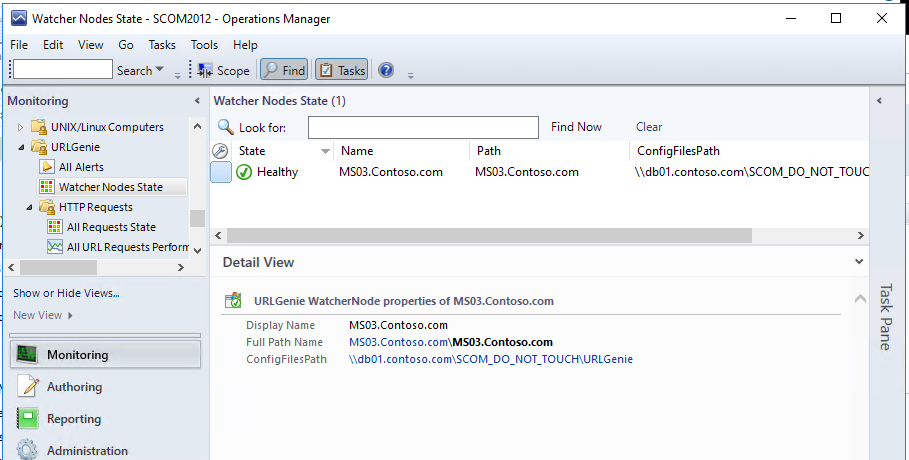
1) Start with a basic text file of URLs/addresses
2) Run the task to generate the config file from this basic list.
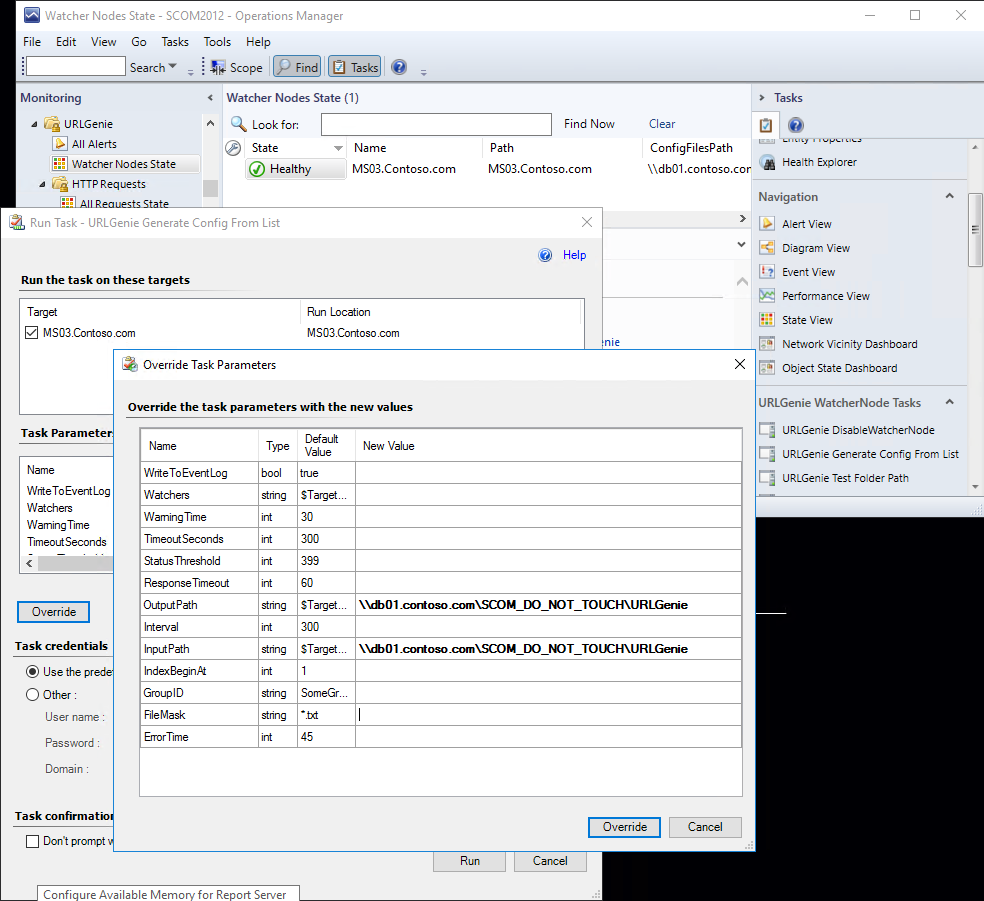
3) Config file is created successfully
4) The configuratoin file is created with default parameters. Feel free to modify the settings as needed.
Notice the <watchers> tag contains "MS02". Any watcher nodes that contain "ms02" (not case sensitive) in their name (FQDN) will be able to discover these instances.
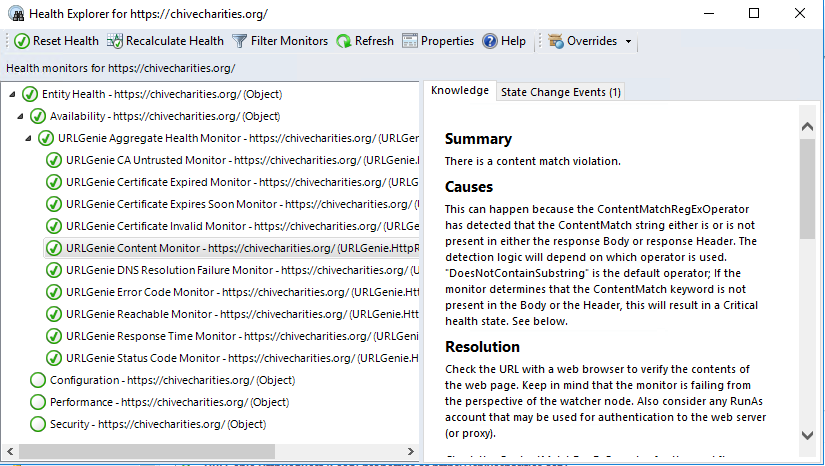
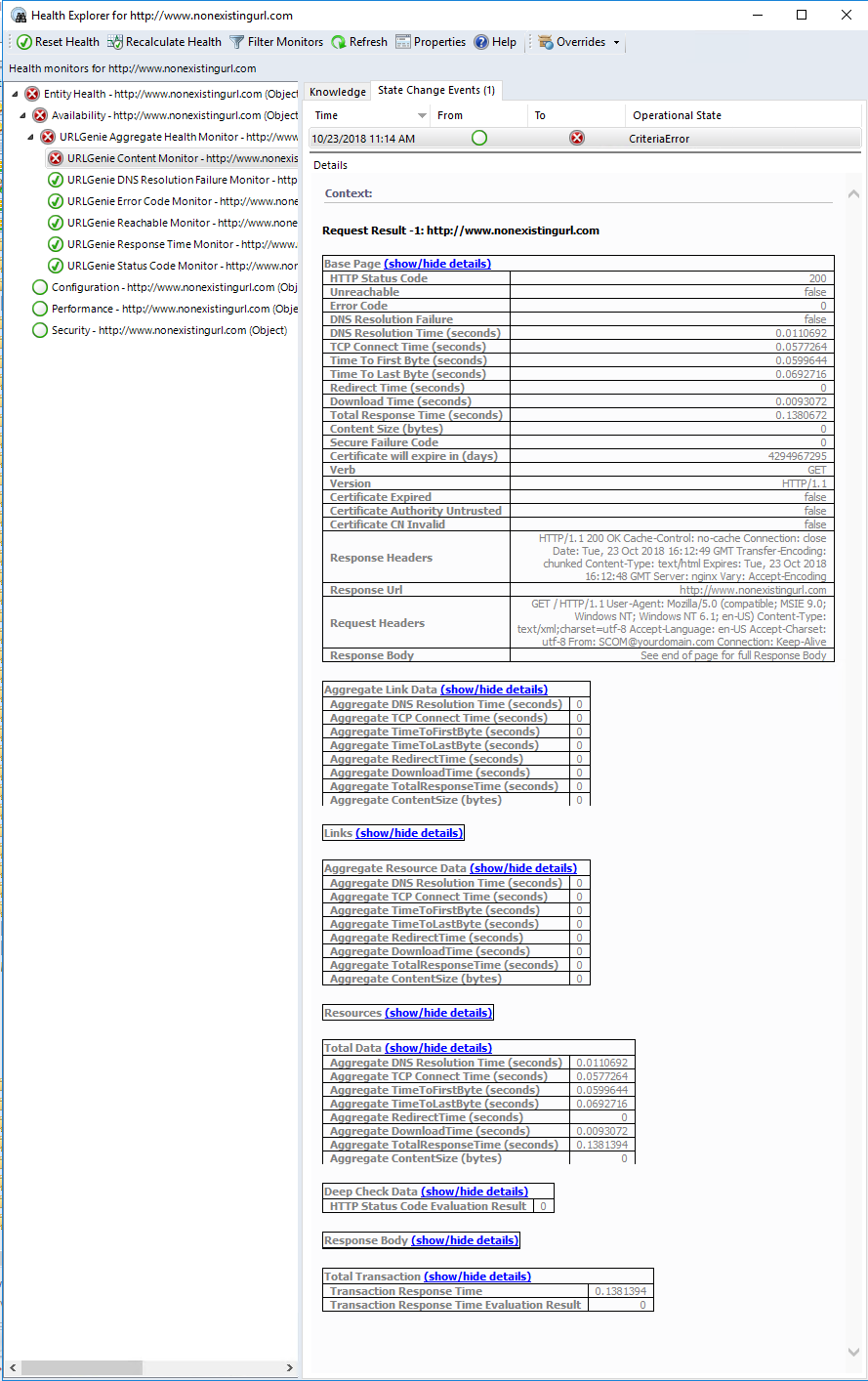
The Scripted IE Login monitor is able to simulate a login, even a 2-page login sequence (1:username, 2:password) like the example below.

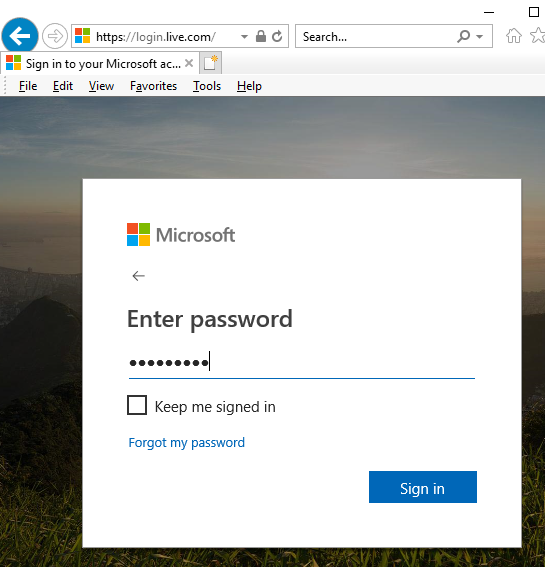
Overview: To configure the IE Login Scripted Monitor
You will need to find the HTML IDs of the elements designated below. You can find the element IDs by enabling “developer mode” (Internet Explorer: F12, Chrome: CTRL+SHFT+I ) and selecting the objects to find the section of source code that defines the element properties. See the management pack guide for full tutorial.
Developer Mode (Internet Explorer)
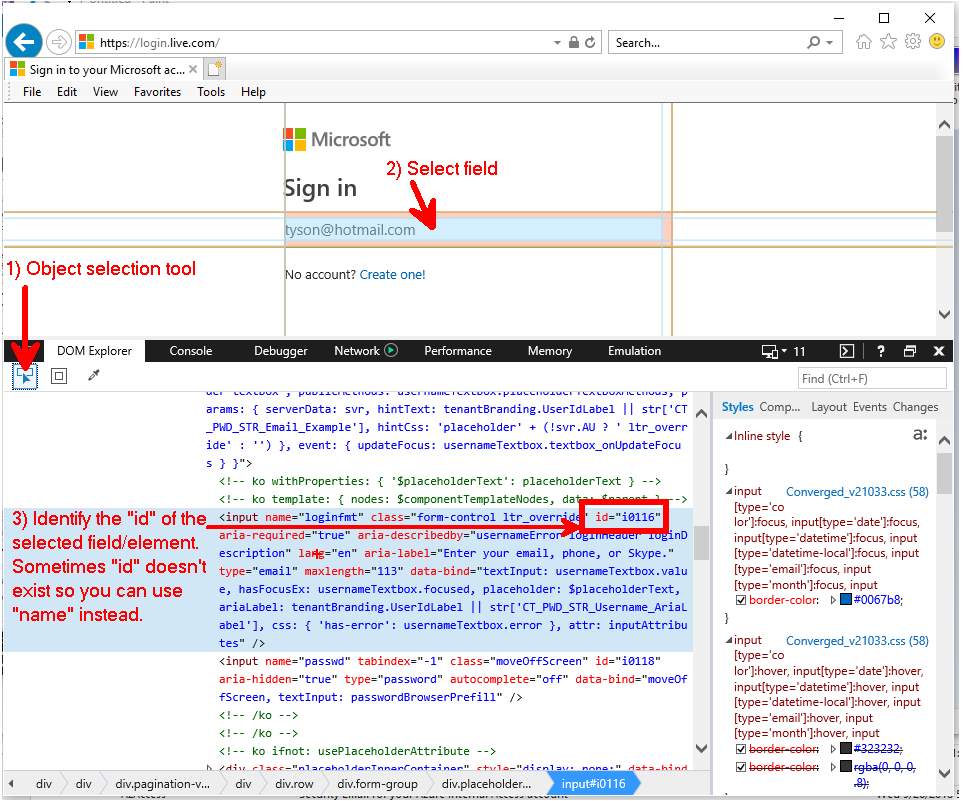
Once you identify the form fields and buttons, you can override the monitor with the necessary values.
Below is an example of a login test with a TWO URL sequence:
https://login.live.com/login.srf^https://account.microsoft.com/devices
The first URL will open the login page (the first of two login pages; 1 for username, 2 for password).
The second URL is the actual target page that will be monitored for a content match: "find my device".
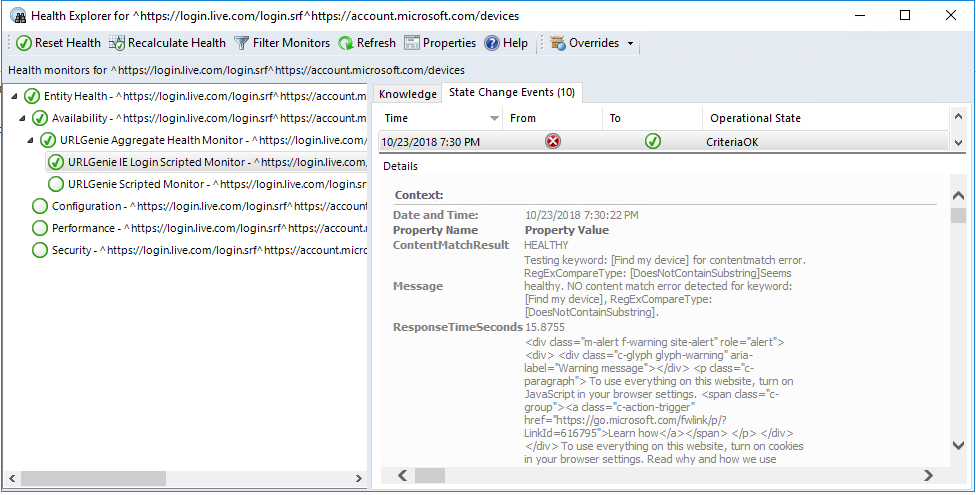
Forced content match error:
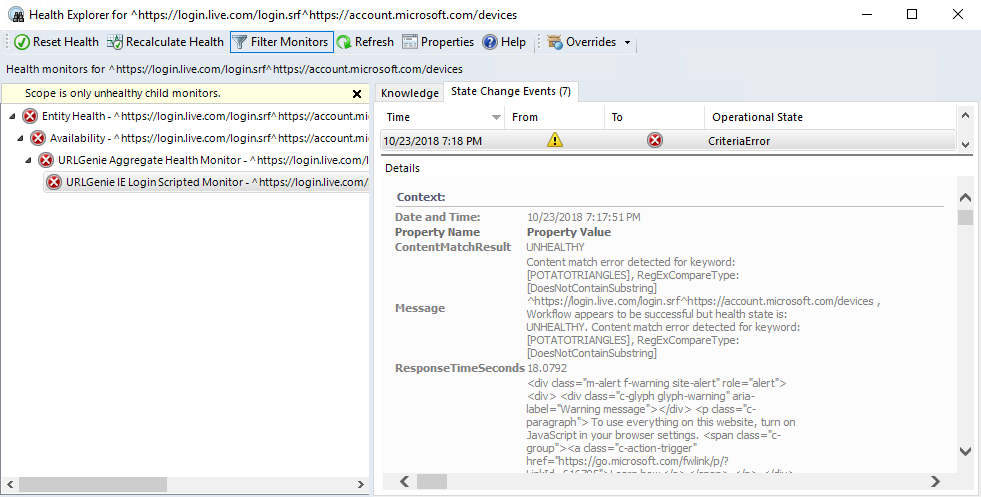
The alert description indicates that the login test was successful but there was a content match error.
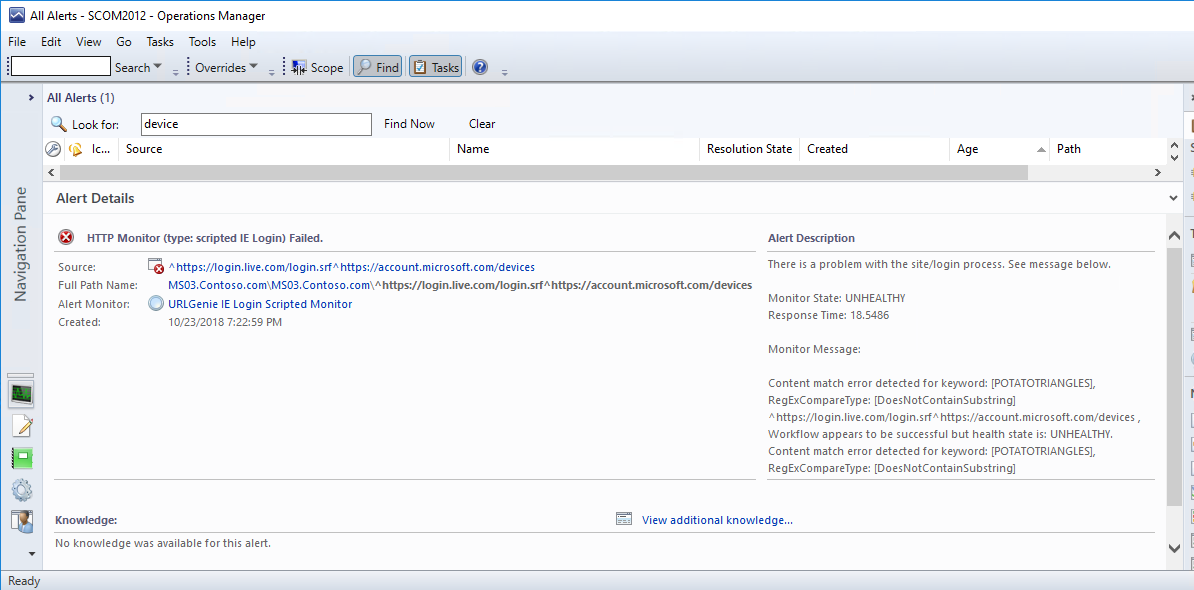
After the ContentMatch field is set to a value that is expected to appear on the target page, the monitor returns to healthy and you can see the expected site text in the context area of Health Explorer.
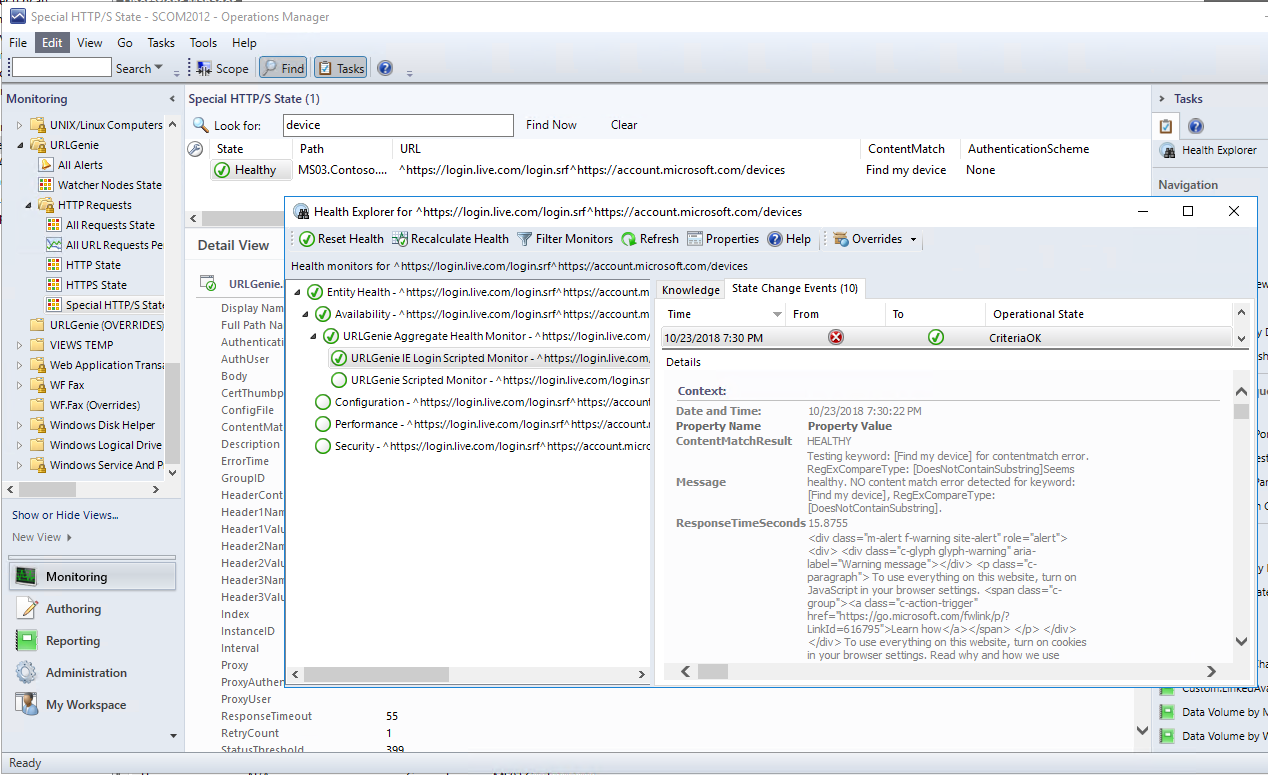
Severity: Critical Error
Severity: |
Critical Error |
Alert Description: |
Content Validation Error Monitor Settings:URL: https://www.qnap.comContentMatch String: hGroupID: URLGenie_DefaultDNSResolutionTime: 0Interval: 300RetryCount: 1Wiki: No link providedDescription: URL address to monitor.******* Request Headers *******GET / HTTP/1.1User-Agent: Mozilla/5.0 (compatible; MSIE 9.0; Windows NT; Windows NT 6.1; en-US)Content-Type: text/xml;charset=utf-8Accept-Language: en-USAccept-Charset: utf-8From: SCOM@yourdomain.comConnection: Keep-Alive******* End Request Headers ************** Response Headers *******ResponseHeaders: HTTP/1.1 200 OKConnection: keep-aliveDate: Sat, 09 May 2015 00:09:25 GMTContent-Length: 1996Content-Type: text/html; charset=UTF-8Last-Modified: Tue, 21 Apr 2015 13:25:30 GMTETag: "4236f2-7cc-5143bfafc0680"Server: Apache******* End Response Headers ******* |
Command Channel: |
MyDev |
Source: |
|
Path: |
MS02.Contoso.com;\\Db01.contoso.com\scom_do_not_touch\URLGenie |
Principal Name: |
MS02.Contoso.com |
Alert Name: |
HTTP Request Error: Content Validation Error |
Alert Resolution State: |
New (0) |
Alert Monitor Name: |
URLGenie Content Monitor |
Alert Monitor Description: |
None |
Time Raised: |
5/8/2015 5:09:25 PM |
Alert ID: |
b1980341-a92d-453a-8fa7-75bc8e8fc003 |
SCOM Operations Console Info: |
|
SCOM Web Console link: |
|
Research It: |
|
ADMIN DIAGNOSTIC INFO |
-------------------- |
**Use this command to view the full details of this alert in SCOM Powershell console: |
get-SCOMalert -Id "b1980341-a92d-453a-8fa7-75bc8e8fc003" | format-list * |
This email sent from: |
MS01.Contoso.com |
CF1: Alert.NetBIOSName: |
MS02 |
CF2: Alert.NetBIOSDomain Name: |
CONTOSO |
CF3: Alert.PrincipalName: |
MS02.Contoso.com |
CF4: SubscriberList: |
Subscribers:TEST Subscriber; |
CF5: Management Pack Name: |
URLGenie Management Pack |
CF6: Alert Class Name: |
URLGenie.HttpRequest |
CF7: Alert.Category |
AvailabilityHealth |
CF8: Workflow Type |
MONITOR |
CF9: |
RESERVED |
CF10: Helpful POSH Command |
get-SCOMAlert -ID "b1980341-a92d-453a-8fa7-75bc8e8fc003" | format-list * |
Context: Note: This context data is only relevant to the moment/time at which this alert was sent. |
type : Microsoft.SystemCenter.WebApplication.WebApplicationDatatime : 2015-05-08T17:09:25.0005666-07:00sourceHealthServiceId : 120875E8-C79E-91CA-E3AC-EA09A391F4BDRequestResults : RequestResultsTransactionResponseTime : 0.0024875TransactionResponseTimeEvalResult : 0CollectPerformanceData : CollectPerformanceData |
The context information for these alerts is not always helpful. To see more detailed information about this alert log into the console for the management group.
Wiki
The context information provided in this notification is limited and is not always helpful. To see more detailed information about this alert, log into the appropriate SCOM console for the applicable datacenter (SCOM management group) and use the Health Explorer to find more details about the state change event for the object.
Please let me know if you have any suggestions for improvements.
Page History:
2018.10.23: Updated screenshots and content to reflect the version 2 updates.
2017.3.16.1330: Added updated MP version info.
2015.11.6: Fixed a typo.
Anonymous
June 03, 2015
Thanks, Tyson! Looks like a very useful solution. I'll be trying this out very soon!
Anonymous
June 22, 2015
Hi Paul,
I'm using (or better want to use ;) ) a Windows 7 machine as a watcher node, even after Updating PowerShell to V 3.0 I'm not able to add the windows 7 machine as a watcher (Still gives the error wrong PowerShell version)
I know this is a know SCOM issue (you need to start PowerShell again from the SCOM script) , but as it works on the servers; I'm not sure if it is the same issue.
Greetings Marc
Anonymous
June 24, 2015
@Powershell Guy: I've run into this problem before with another client. They were able to update the Windows Management Framework to v4.0 on the Windows 7 machine, and this solved the problem.
www.microsoft.com/.../details.aspx
Please let me know your findings. If you still encounter problems, please email screenshots to me.
Anonymous
July 06, 2015
Thanks. Will be testing this soon.
Anonymous
July 23, 2015
Looks really good but i'm having trouble with a scripted IE monitor trying to log into a forms authenticated site - the submit button doesn't have an ID just
<input name="login" class="submit button-1" type="submit" value="Login">
Is there any way to get this to work?
Anonymous
July 27, 2015
PaulO,
I've run into this before and I was able to get it to work correctly by simply using the input name which, in your case, is "login". Let me know if you still have problems.
-Tyson
Anonymous
July 28, 2015
Thanks Tyler,
I gave that a shot, still no joy the page being returned is the login page (rather than the logn failed try again page). Just to rule out the login profile I overrode the username/password in the monitor to the actual strings (still no good). Just to make things harder I'm trying to monitor a service that is hosted by a third party so I don't have access to access logs - I suspect i'll be firing up fiddler or similar on watcher node.
Cheers
PaulO
Anonymous
July 28, 2015
PaulO,
Can you try to see if you have Mshtml.dll registered correctly on your watcher node? Try running this command from an elevated Powershell console:
Get-ChildItem C:Windows -include "Microsoft.mshtml.dll*" -Recurse
Anonymous
July 28, 2015
Thanks again Tyler,
Output is below - the probe is honouring the contnetmatch - so I suspect this isn't the problem
PS C:Windowssystem32> Get-ChildItem C:Windows -Include "Microsoft.mshtml.dll" -Recurse
Directory: C:WindowsassemblyGACMicrosoft.mshtml7.0.3300.0__b03f5f7f11d50a3a
Mode LastWriteTime Length Name
---- ------------- ------ ----
-a--- 15/05/2015 10:32 AM 8013664 Microsoft.mshtml.dll
Cheers,
Paul O
Anonymous
August 21, 2015
The comment has been removed
Anonymous
September 01, 2015
if i need to monitor the url via proxy, how can i configure it
Anonymous
September 01, 2015
Steven, See the management pack guide. I've copied/pasted some of the configuration file element definitions below. You must configure these within the configuration file(s).Proxy [string, URL]Default: <blank>Description: Optional. Address of your proxy server.ProxyAuthenticationScheme [string] <"None" | "Basic" | "Digest" | "NTLM" | "Negotiate">Default: "None"Description: If authentication method other than None is used, you will have to specify a username (see ProxyUser) and also configure a Basic account type in the Console, then assign that account to the object instance with the "URLGenie Proxy Account".ProxyPass [Basic Account Type, configured in the Console]Default:Description: THIS IS NOT CONFIGURED IN THE .XML CONFIG FILE. However, this parameter is overrideable for most monitors. If ProxyAuthenticationScheme authentication method other than None is used, you will have to specify a username (see ProxyUser) and also configure a Basic account credential type in the Console, then assign that account to the object instance with the URLGenie Proxy Account profile. Only the password from this credential object is used.ProxyUser [string]Default: <blank>Description: Username for use with Proxy authentication. Note: the password must be configured in the Console with a Basic Account type. Here is an example of what your elements might look like in the configuration file when using a proxy with NTLM:<url><![CDATA[http://www.somewebsite.com]]></url>......<proxy><![CDATA[http://proxy.contoso.com:8080]]></proxy><proxyauthenticationscheme>NTLM</proxyauthenticationscheme><proxyuser>contosoksmith</proxyuser> You would create a Basic Account:name: KSmith Proxy Access Accountusername: <doesn't matter, use anything>password: <password for domain user account: contosoksmith >The domain user account "KSmith" must exist in Active Directory.Add the "KSmith Proxy Access Account" to the URLGenie Proxy Account profile and apply it to the Object:http://proxy.contoso.com:8080 http://www.somewebsite.com Here's an example of what your elements might look like in the configuration file when using a proxy with no authentication (None).<url><![CDATA[http://www.somewebsite.com]]></url>......<proxy><![CDATA[http://proxy.contoso.com:8080]]></proxy><proxyauthenticationscheme>None</proxyauthenticationscheme><proxyuser></proxyuser>
Anonymous
September 02, 2015
it is a must to include <![CDATA? . my proxy is not in internet url format.
Anonymous
September 02, 2015
@Steven: CData is not required but is helpful when your URL contains special characters.
Anonymous
September 02, 2015
The comment has been removed
Anonymous
September 02, 2015
i can't get it working with or withput CData. How long would it take effect after edited the .xml. The proxy is with None authentication.
Anonymous
September 03, 2015
@tyson, i still not able to get it working for proxy and web which require password by follow the guide
Anonymous
September 03, 2015
@Steven: Use the "Email Blog Author" link above and I will do my best to assist you directly via email.
Anonymous
October 27, 2015
First off, this is GREAT! Being able to whip up monitoring on a list of URLs almost instantly is a huge time saver. I have a question regarding monitoring the same URL multiple times though. I have multiple websites that are hosted on multiple servers for redundancy. So I'd like to check Website A and Website B both on Server 1 and Server 2. How I currently have it setup is to check "http://Server1" and send the HOST header of "www.WebsiteA.com" on 1 request and "www.WebsiteB.com" on another. It looks like the URL Genie views this as 2 checks for the same URL so it only sends 1. Example being I see the monitor for Website B on Server 1, but not for Website A.
Is there a better way of doing this, or a way of doing this at all? Any help would be great. Thanks so much!
Anonymous
November 16, 2015
Great tool thx, it could save us a lot of time :-)
The only challenge we have is, that it seems that the "retry count" doesn't seem to work.
We expected with the setting in the xml, for a url :
Anonymous
November 17, 2015
@Marcel,
The retry count problem is a known bug in the underlying module.
Anonymous
November 17, 2015
@Paul
Thanks for your quick answer, unfortunately it's not the answer we hoped for :o)
Is there any development going on for the urlgenie pack? Can it be fixed within the pack, or can we better focus on another solution? thx again!
Anonymous
November 17, 2015
Trying to find if I can monitor for statuses >399. I need to monitor a subset of sites that use IP filtering, and I need to see anything more than 399 as a success, rather than a failure, is this possible?
Thanks
Anonymous
November 17, 2015
@Marcel,
Unfortunately it is the product group that must fix the underlying code of the module. When I get a chance I'll revisit that issue and see if I can get update on the bug status.
Anonymous
November 17, 2015
@Hales,
I can look into other possibilities but as of now the comparison logic will only use > for an error detection. Ping me next month and I may have good news for you.
Anonymous
November 25, 2015
Also, using the IE scripted login - is there a way to handle ADFS logins?
i.e: Go to a website, click on a button, authentication pops up redirecting through ADFS before reaching page
Anonymous
November 26, 2015
@Paul.
great MP. We now have 98 URL's to monitor. All "simple" URL-checks.
So far so good.
Now we need to insert 15 URL's that need a client-side certificate.
I extracted the thumbprint and entered it into the xml-entry.
unfortunately there's an error. No certificate found on server...
Provider of the certificate is 100% sure it's the right certificate...
Any idea???
Grtz. Rene
Anonymous
December 09, 2015
@Paul - And one final thing, is there any way for changing the display name so it's not just the URL?
Thanks
Anonymous
December 12, 2015
@Hales: Nope. However, you can use the "Description" field for this purpose.
Anonymous
December 12, 2015
@Rene: Override the workflow, set WriteToEventLog parameter to 2 then check the event log on the watcher node for more detail.
Anonymous
January 21, 2016
Why is my watcher node trying to connect to 93.184.221.200?
Aliases: download.gigabyte.eu
gigabytestorage.azureedge.net
gigabytestorage.ec.azureedge.net
Anonymous
January 21, 2016
Paul,
sorry for the late respone..Due to other work, I wasn't able to test htis earlier... Again Sorry.
Message I get in event-log:
The term 'Invoke-WebRequest' is not recognized as the name of a cmdlet
Check on the watcher-node says: Powershel version 4 -1 -1
invoke-webrequest in Powershell ISE works localy on watchernode.
Certificate is found when I logon localy on watchernode...
Any other Idea what I'm doing wrong??
Thanx....... Rene
Anonymous
January 24, 2016
Paul, thnx for the advise.
Error I see in eventlog is: The term 'Invoke-WebRequest' is not recognized as the name of a cmdlet, function, script file, or operable program. Check the spelling of the name, or if a path was included, verify that the path is correct and try again.
When I enter the same invoke-webrequest on the watcher-node localy it works fine. PSversion = 4..
Anonymous
January 27, 2016
Hi,
we made our first tests with URLGenie and it looks great.
But we have one Problem to solve, so that we can use ist for all our checks.
We send a XML to a secific URL and get a Response back. We check the returning XML by ContentMatch. The Problem now ist, that there are two or more allowed strings, that may come back. We only can check one string, so the other positive strings get an negative result.
Is there a possibility to have more strings or regular expressions allowed?
Thanks,
Jörg
Anonymous
February 09, 2016
Hi Paul,
How can I remove monitored URLs? I have some test URLs going on with URLGenies but not be able to remove them.
Thanks,
X
Anonymous
February 09, 2016
@X, rename the config file(s) to Requests_whatever.xml.BAK.
Or you could delete them but I think renaming is better. As long as the discovery workflow can still access the configured shared folder path, it should undiscover the URLs when it finds zero config files.
Anonymous
February 09, 2016
@Keegs,
I don't have an easy workaround for you at this time. Perhaps add a trailing slash to make the second URL unique.
1). www.something.com
2). www.something.com/
Anonymous
February 09, 2016
@Paul, I have removed them in configuration file but it won't go away, I will follow your instruction to rename or delete Request file.
It is awesome MP with a lot of manual steps, haha. We are going to save x,000 dollars from it.
Thank you,
X
Anonymous
February 09, 2016
@Paul, yes, it worked. Removed all URLs.
Thanks.
Anonymous
February 09, 2016
@Jörg:
You can override the ContentMatch monitor.
Override this parameter: ContentMatchRegExOperator
with this value: DoesNotMatchRegularEspression
Use a regular expression for the ContentMatch value; something like this: s*(firststring|second|third)
For more content matching operator options see "ContentMatchRegExOperator" in the "Parameters and Instance Properties" section of the management pack guide.
Anonymous
February 09, 2016
@Marcel,
I think I might have a way to solve the RetryCount issue but I won't have time for this side project until a few months down the road.
Anonymous
March 11, 2016
I am sorry for asking this, but How can I remove the URLGenie MP?
I couldn't make it work, and I would like to remove it properly from SCOM
Anonymous
March 11, 2016
@Juan,
I'm happy to help you get it configured. However, if you want to remove it, simply delete the management pack.
Anonymous
March 23, 2016
The comment has been removed
Anonymous
April 07, 2016
Tyson first off thanks for creating this wonderful MP this will be truly helpful (if I can get it to work ; ) which is why I'm reaching out to you. I'm very very new to SCOM but I have installed and configured a new 2012 R2 environment and I have deployed your MP per your thorough instructions. However I can't seem to produce any url monitoring traffic which tells me something is wrong somewhere I just don't know where. Watcher node is present, xml file created, permissions are all set. Haven't noticed any errors in Ops log reference this MP. Any suggestions would be greatly appreciated.
Anonymous
April 14, 2016
I was able to successfully configure URL monitor for website answering on port 80, but getting errorcode violation "2147500037" for other URLs which include port non-standard port numbers within the URL.Example: http://server.domain.com/test - SuccessExample: http://server.domain.com:7777/test - Errorcode "2147500037"
Anonymous
June 15, 2016
The comment has been removed
Anonymous
June 15, 2016
Scripted IE login portion does not work. The first URL will work but all others fail. Deleting MP.
Anonymous
July 13, 2016
Hi there Tyson,Thanx for this MP. I am trying to get form login working for the same webpage from your tutorial: https://login.live.com. The UsernameElementID, PasswordElementID and ClickButtonID is still the same. However I get this message:There is a problem with the site/login process. See message below. Monitor Status: SuccessResponse Time: 12944Monitor Message: Response time [ 12944 ] exceeded threshold: [120 seconds.]..while attempting to fetch: [https://login.live.com/]____InnerText:Navigation to the webpage was canceledWhat you can try:Refresh the page.Refresh the page. ____ErrorData below:Any ideas? I do not get any popups etc when logging in manually from the concerning watcher.Thanx in advance.Regards,Chris
Anonymous
August 26, 2016
Hi Paul,we have a proxy problem when implementing your MP.we must create a user for proxy account (OK), associate this account to profile (OK) and associate this profile to proxy object (NOK)in step :Add the "KSmith Proxy Access Account" to the URLGenie Proxy Account profile and apply it to the Object:http://proxy.contoso.com:8080We haven't proxy object defined in scom. so, how can we do?How to create this object??? (sorry, we are newbee in scom :-) ).Laurent
Anonymous
August 29, 2016
The comment has been removed
Anonymous
October 05, 2016
Hi Paul,Any way to set up different recovery tasks for each URL?Thanks!
Anonymous
October 21, 2016
The comment has been removed
Anonymous
October 21, 2016
Hi Paul,Great work! Thank you!Testing https://login.live.com/ - what do you use for AuthenticationScheme? I read every page of your MP guide. I am trying your test on https://login.live.com/; however, I get the same result as Chris.Many thanks,Martin
NetbiosDomainName\WEBMON. So if my domain were Contoso.com with Netbios domain name of "Contoso" this would be my authuser value:Contoso\WEBMONThe RunAs account should be configured as a "Basic Authentication" account type, not Windows. The account should be added to the URLGenie Proxy Profile for the URL instance/object.If you continue to have problems, send me email. My address can be found in the MP guide. -TAnonymous
December 05, 2016
Hi Tyson. Thank you for this great addition to SCOM.After using it for a while, were moving to SCOM 2016, can you confirm that URLGenie will work without any issues, or should we do some extra testing on it?
Anonymous
December 15, 2016
Hi PaulI need to monitor the availability SharePoint from internet. We have a two-tier authentication - with certificate and user login. The first step after entering the url is checked user certificate, then the user login using MS TMG and finally the welcome page of the SharePoint Portal. This can be monitored by your MP?
Anonymous
December 16, 2016
Thanks for the reply, Paul!
Anonymous
December 21, 2016
Hi Paul,I've set up this MP in our environment because of the client certificate capabilities, but I'm running into some issues. I've followed the guide, but when I create an XML file with the correct certthumbprint and place it in our URLGenie folder, it doesn't create a URLGenie.HttpsRequest monitor. Instead it just makes a regular URLGenie.HttpRequest monitor even though the URL is https://server.domain.net:1234/index.html. I haven't changed any of the other default settings so I'm wondering if there's a step I'm missing along the way.Any advice would be appreciated.
Anonymous
December 27, 2016
Hi Paul,Do you have a release date for the next version of this MP?I'm looking forward to the retry count feature that you mentioned a couple of months ago.Kind regards,J.
Anonymous
February 09, 2017
Great job Tyson: congrats and thanks for sharing!
Anonymous
February 16, 2017
Tyson, I have a question that I may have missed being answered in this post/comments. However how can I prevent duplicate notifications, or rather only send (or raise) an alert if one of the watcher nodes fail? The goal is simply to ensure on a failure that the 'end user' for the alert only receives one notification, instead of one for each watcher node that reported the failure.For our setup, if we have the Requests xml on a server that two nodes access, and the configuration for the websites is via the (.) period, to ensure all watcher nodes in the event we add/remove watcher nodes that this is easily picked up.I have a feel there is something simple that I am missing, but help from you or anyone else would be greatly appreciated.Thank you!
Anonymous
March 12, 2017
Hey Tyson,Great MP, have used it at many of my customers. Just some minor feedback, I would change the way the targetting of the tasks work.Right now it is targetted to Logical Entity, so it's showing up for each alert/object you select in the console.Other than that, keep up the good work!
Anonymous
September 24, 2017
HiI was wondering about the content monitoring. How come you have "hidden" the DoesNotContain in an override? One of the stronger sides of this MP is that it shows the properties in the config file in the alert. This makes it easier to see what the configuration is for the website you are checking. Since the DoesNotContain isn't in the property files it makes it a bit confusing.
Anonymous
October 23, 2017
I don't know if I missed this note anywhere, but I've discovered that all the config files can not share the same index value/range otherwise it stays unmonitored state forever.
Anonymous
November 14, 2017
I continuously get this critical alert in the Operations Manager log. What exactly is wong here? All of my monitors are working and there are 0 alerts in the SCOM console.Log Name: Operations ManagerSource: Health Service ScriptDate: 11/14/2017 5:20:00 PMEvent ID: 9999Task Category: NoneLevel: ErrorKeywords: ClassicUser: N/AComputer: scomDescription:Script_798ac417fb2e429fbca5f6b9e85e4bdd : Message: Problem with URL! [] Skipping.Username: SCOM$ThisScript: RequestDiscovery.ps1TimeStamp: 20171114172000206SourceID: {A165AC7C-8271-148D-4AEC-961FB1CAAB55}ManagedEntityID: {AC8E907B-2A68-0CEF-F28D-1831323F7C9B}PrincipalName: scomThisComputer: [scom]ConfigFilesPath: [ \scom\SCOM_DO_NOT_TOUCH\urlgeniefiles ]ThisFile: [ \scom\SCOM_DO_NOT_TOUCH\urlgeniefiles\Requests_List_of_URLs.xml ]url: LowerDiscoveryPercentage: 0UpperDiscoveryPercentage: 100Total number of objects detected in path: 18Subset of objects to be discovered: 1 .. 18Subset total count: 18index: watchers: []groupid: headercontenttype: header1name: header1value: header2name: header2value: header3name: header3value: responsetimeout: 0retrycount: 0interval: 0statusthreshold: 0contentmatch: proxy: wiki: authenticationscheme: warningtime: 0errortime: 0certthumbprint: body: Any Errors: Event Xml: 9999 2 0 0x80000000000000 423433 Operations Manager scom Script_798ac417fb2e429fbca5f6b9e85e4bdd Message: Problem with URL! [] Skipping.Username: SCOM$ThisScript: RequestDiscovery.ps1TimeStamp: 20171114172000206SourceID: {A165AC7C-8271-148D-4AEC-961FB1CAAB55}ManagedEntityID: {AC8E907B-2A68-0CEF-F28D-1831323F7C9B}PrincipalName: scomThisComputer: [scom]ConfigFilesPath: [ \scom\SCOM_DO_NOT_TOUCH\urlgeniefiles ]ThisFile: [ \scom\SCOM_DO_NOT_TOUCH\urlgeniefiles\Requests_List_of_URLs.xml ]url: LowerDiscoveryPercentage: 0UpperDiscoveryPercentage: 100Total number of objects detected in path: 18Subset of objects to be discovered: 1 .. 18Subset total count: 18index: watchers: []groupid: headercontenttype: header1name: header1value: header2name: header2value: header3name: header3value: responsetimeout: 0retrycount: 0interval: 0statusthreshold: 0contentmatch: proxy: wiki: authenticationscheme: warningtime: 0errortime: 0certthumbprint: body: Any Errors:
Anonymous
November 20, 2017
The comment has been removed
Anonymous
December 04, 2017
Has anyone tried this with SCOM 2016? Works fine except it seems the retry count is back to being broken. I am using the latest version where it had been fixed. It's still working fine in my 2012 R2 environment, but the retry count is not working in my 2016 environment.
<retrycount> value is only effective if the monitor detects a failure (matches an error/critical condition) organically, so to speak. If you override one of the criteria to force an error condition OR if you change a criteria property in the config file to force an error condition (which results in new discovery data submission) then the monitoring workflow is executed immediately upon loading of the new configuration by the agent and the RetryCount is ignored which makes the health state flip immediately. I believe this is by design. For normal monitoring whereby the behavior of the watched instance changes, and not the criteria, RetryCount works perfectly as designed. In conclusion, it still works "correctly" in SCOM 2016.Anonymous
December 12, 2017
The comment has been removed
Anonymous
March 09, 2018
Hi TysonYes, we read this! ;)We would be very interested in testing the newest version of URLGenie! More so as we recently discovered that in alerts raised by the "URLGenie CA Untrusted Monitor" unit monitor, the alert description still contains the placeholders and not the data:Certificate Authority ErrorMonitor Settings:URL: {0}GroupID: {1}DNSResolutionTime: {2}Interval: {3}RetryCount: {4}Wiki: {5}Description: {6}******* Request Headers {7} End Request Headers ************** Response Headers ResponseHeaders: {8} End Response Headers *******Did we miss a configuration step here or is a bug?Greetings,Raphael
Anonymous
May 01, 2018
Hi, I'm interested in this MP. Please let me know how to test. Thanks.
Anonymous
June 14, 2018
Hi Tyson,thanks for this MP, as it is exactly what i was looking for.I want to monitor a website using a client certificate, but the event log keeps telling me, that NO matching certificate has been found.What i already did:I generated the config file with the integrated task out of a .txt file and did not change anything except the certthumbprint section. I read, that you removed the "URLGenie.URLGrabScripted.ClientCert.Monitor" but integrated the functionality into the "URLGenie.URLGrabScripted.MT". I did override this monitor, to enable it. The monitored URL correctly shows up in the "HTTPS Requests" view in SCOM and the Health Explorer tells me, that "URLGenie Scripted Monitor" is the only enabled monitor. Sadly, the status is critical, as "no matching certificate was found"The client cert, whose thumbprint i added to the config file, correctly shows up on the Watcher node when entering "gci Cert:\LocalMachine\my".I checked, whether the config file is UTF-8 and whether the SYSTEM Account (which is my OMAA) has access rights to the private key in the certificate. But everything seems to be configured just fine.What am i missing?Thanks a lot in advance!Torsten
Anonymous
June 21, 2018
The comment has been removed
Anonymous
August 07, 2018
The comment has been removed
Anonymous
November 14, 2018
The comment has been removed
Anonymous
January 10, 2019
Hi Tyson,sorry to bother you again. I'm not asking you to solve the following problem for me, but perhaps you already saw such a behavior elsewhere:Since we recycle our IIS AppPools every night, which led to a flood of alerts, i set up a maintenace schedule in our SCOM 2016 for 1 hour during which these recycles are done. But every night, after the maintenance schedule ends, many websites are reported as "critical" just to become healthy one minute later. e.g. the maintenance ends at 4 am. 6 minutes later, a website is reported as "critical" (Content, Reachable and Error Code monitors). Another minute later, the monitor switches back to healthy.This leads to hundreds of mails every night, so the maintenance schedule is causing more mails, than we would get without it. And only URL Genie is affected. We struggled with this problem for several months now and i did not yet have any idea how to solve that.Might this be a bug or am i just not understanding the way maintenance mode works?Thanks in Advance!RegardsTorsten
Anonymous
January 11, 2019
Hi Paul,we are just starting to use your wonderful management pack and have come across a site that throws errors. Actually two alerts are raised it:1. HTTP Request Error: ErrorCode Exceeded ThresholdErrorCode Exceeded ThresholdErrorCode: 2147954444Monitor Settings: URL: https://nwpo.GroupID: SomeGroupTagDNSResolutionTime: 0RetryCount: 0Wiki: No link providedDescription: URL address to monitor. Request Headers ******GET /startPage HTTP/1.1User-Agent: Mozilla/5.0 (compatible; MSIE 9.0; Windows NT; Windows NT 6.1; en-US)Content-Type: text/xml;charset=utf-8Accept-Language: en-USAccept-Charset: utf-8From: SCOM@yourdomain.comConnection: Keep-AliveThat error code translates into ERROR_WINHTTP_CLIENT_AUTH_CERT_NEEDED. The second alert is:HTTP Request Error: Content Validation ErrorThis one does not show anything in the response headerMonitor Settings: URL: https://ContentMatch String: hGroupID: SomeGroupTagDNSResolutionTime: 0Interval: 300RetryCount: 0Wiki: No link providedDescription: URL address to monitor. Request Headers *******GET /irj/portal HTTP/1.1User-Agent: Mozilla/5.0 (compatible; MSIE 9.0; Windows NT; Windows NT 6.1; en-US)Content-Type: text/xml;charset=utf-8Accept-Language: en-USAccept-Charset: utf-8From: SCOM@yourdomain.comConnection: Keep-AliveCan you point is in a direction on how to solve that ? We can open the URL ok in a browserThanks Thorsten
Anonymous
February 19, 2019
Really struggling with getting the IE Scripted PowerShell script to run on Server 2016, IE 11.I have extracted the script from the MP, and have populated the test variable with the relevant data. Debugging the script in ISE, gets up to where the script block is ran via invoke-command. I'm sure the script block is being executed, because ProblemDetected function is called. $InnerText just doesn't contain anything??? Is there anything I can do, to break it down, simplify the invoked script block piece to ascertain where the failure\error is occurring?If I run it on Server 2012 R2, IE11 we are gold!
Anonymous
March 07, 2019
Hello Tyson, I am new to this MP but I can't seem to get this example to work that you gave. Where do I change the overrides below? I can't see these overrides in the scripted monitor. Goal: To ignore 402 and 404 but anything else over 400 will result in Critical In the config file: ...400402,404...Override the monitor:ErrorOnNoContentMatch = 0CheckErrorData = 1
Anonymous
April 08, 2019
Hi Paul,I would like to kindly ask you for a feedback in the scenario below.One of the watcher nodes stopped to record the additional performance for all HTTP URLs but all HTTPS URLs are recorded properly.There is no change in the override settings and the same URLs are fine for the rest of the watchers.Clearing the cache of the agent does not help.Any suggestion would be highly appreciated.Thank you. Nicu
Please sign in to use this experience.
Sign in